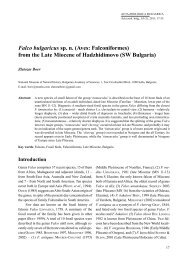Gyps bochenskii sp. n. (Aves: Falconiformes) from the Late ... - ecodb
Gyps bochenskii sp. n. (Aves: Falconiformes) from the Late ... - ecodb
Gyps bochenskii sp. n. (Aves: Falconiformes) from the Late ... - ecodb
Create successful ePaper yourself
Turn your PDF publications into a flip-book with our unique Google optimized e-Paper software.
<strong>Gyps</strong> <strong>bochenskii</strong> <strong>sp</strong>. n. (<strong>Aves</strong>: <strong>Falconiformes</strong>) <strong>from</strong> <strong>the</strong> <strong>Late</strong>....<br />
philisi), Eucladoceros senezensis cf. vireti HEINTZ,<br />
1970, Cervidae gen. et <strong>sp</strong>. indet., Gazello<strong>sp</strong>ira <strong>sp</strong>.,<br />
Megalovis aff. latifrons SCHAUB, 1923, Equus stenonis<br />
vireti PRAT, 1964 (SPASSOV 2000; 2003) and<br />
Megantereon cultridens (CUVIER 1824) (BOEV 2008).<br />
The mammal fauna refers <strong>the</strong> site to <strong>the</strong> MN<br />
17/MNQ17 (MEIN 1990, GUERIN 1990) and to <strong>the</strong><br />
St. Vallier Faunal unit of GLIOZZI et al. (1997) and<br />
includes it in <strong>the</strong> time <strong>sp</strong>an after Roccaneyra and before<br />
St. Vallier, thus giving an approximate absolute<br />
age of Varshets between 2.4 and 2.1 Ma (SPASSOV<br />
1997, 2000, 2003, POPOV 2001, 2003, 2004).<br />
Amphibia: Three <strong>sp</strong>ecies of Anura (BOEV, unpubl.<br />
data).<br />
Reptilia: Eight <strong>sp</strong>ecies of Squamata (Sauria<br />
and Ophidia) and one <strong>sp</strong>ecies of Testudines<br />
(Testudo/Eurotestudo <strong>sp</strong>.) (BOEV, unpubl. data), giant<br />
land tortoise, Varanidae gen. indet. (N. TSANKOV,<br />
NMNHS – pers. comm.), Pseudopus apodus (PALLAS<br />
1775) (MADELAINE BOHME, Ludwig-Maximilians<br />
University, Munich; N. TSANKOV – pers. data).<br />
Invertebrates: Gastropoda terrestria: Two <strong>sp</strong>ecies<br />
(BOEV, unpubl. data).<br />
Material and Methods<br />
Abbreviations: Anatomical: dex. – dextra; dig. – digitus,<br />
digiti; dist. – distalis; f. a. – facies articularis;<br />
max. – maximum; min. – minimum; proc. – processus,<br />
processi; prox. – proximalis; sin – sinistra; s. a.<br />
– sulcus articularis; Institutional: BMNH – Natural<br />
History Museum, formerly British Museum (Natural<br />
History), Tring; ISEAK – Institute of Systematics<br />
and Evolution of Animals (Polish Academy of<br />
Sciences), Krakow; NMNHS – National Museum of<br />
Natural History (Bulgarian Academy of Sciences),<br />
Sofia; UCBL – University Claude Bernard, Lyon 1.<br />
The material was collected through screening<br />
and washing of <strong>the</strong> sediments between July 1990<br />
and September 1993. It is kept in <strong>the</strong> NMNHS, and<br />
consists of six <strong>sp</strong>ecimens, representing four skeletal<br />
elements of <strong>the</strong> pectoral girdle, forelimbs and<br />
hindlimbs: sternum, pars coracoidalis, NMNHS 248<br />
(rostrum sterni, s. a. coracoideus sin. and medial part<br />
of s. a. coracoideus dex., and <strong>the</strong> inceptiopn of crista<br />
sterni are preserved; Fig. 1 a, b); sternum, pars costalis<br />
sin., NMNHS 154 (proc. costales II, III, IV and<br />
V are preserved; Fig. 1 c, d); coracoid dex., NMNHS<br />
246, pars humeralis (Fig. 2 a, b, c); coracoid dex.,<br />
NMNHS 247, pars sternalis (Fig. 2 d, e); phalanx<br />
dist. dig. majoris sin., NMNHS 160 (Fig. 3 a, b, c);<br />
phalanx dist. dig. I pedis sin., NMNHS 159 (Fig. 4 d,<br />
e). The findings have been identified through reference<br />
to comparative bird collections of <strong>the</strong> ISEAK,<br />
BMNH, NMNHS, and UCBL (see abbreviations in<br />
<strong>the</strong> Introduction section).<br />
Measurements (in mm; Fig. 4): Sternum, pars<br />
coracoidalis (A): a – distance between <strong>the</strong> medial<br />
edges of <strong>the</strong> labrum dorsale, b – width of rostrum<br />
sterni, c – thickenes of pila coracoidea in <strong>the</strong> base of<br />
pila carinae, d – height of rostrum sterni; Sternum,<br />
pars costalis sin. (B): a – min. thickness of incisura<br />
intercostalis I-II, b – thickness in proc. costalis II,<br />
c – min. thickness of incisura intercostalis II-III, d<br />
– thickness in proc. costalis III, e – min. thickness<br />
of incisura intercostalis III-IV, f – thickness in proc.<br />
costalis IV, g – min. thickness of incisura intercostalis<br />
IV-V, h – thickness in proc. costalis V, i – distance<br />
between proc. costalis II and proc. costalis IV, j –<br />
distance between proc. costalis IV and proc. costalis<br />
V; Coracoid, pars humeralis (C): a – medial width of<br />
<strong>the</strong> acrocoracoideus, b – distance between <strong>the</strong> dorsal<br />
(cranial) edge of fossa pneumatica and <strong>the</strong> inception<br />
of f. a. clavicularis, c – thickness of f. a. clavicularis,<br />
d – thicknes of proc. acrocoracoideus; Coracoid,<br />
pars sternalis (D): f – max. thickness of f. a. sternalis;<br />
Phalanx dist. dig. majoris (E): a – length of<br />
<strong>the</strong> medial edge of f. a. interphalangealis, b – length<br />
of <strong>the</strong> dorsal edge of <strong>the</strong> f. a. interphalangealis; c –<br />
length of <strong>the</strong> ventral edge of f. a. interphalangealis,<br />
d – ventral diagonal thickness of <strong>the</strong> proximal end of<br />
<strong>the</strong> phalanx; Phalanx dist. dig. I pedis (F): a – total<br />
length, b – height of f. a., c – max. length of <strong>the</strong> basal<br />
part, d – min. length of <strong>the</strong> basal part.<br />
The taxonomy follows THIOLLAY (1994). The<br />
osteological terminology is after BAUMEL & WITMER<br />
(1993) and, in some re<strong>sp</strong>ects, KOMAREK (1979). The<br />
chronostratigraphy follows MEIN (1990). All measurements<br />
have been taken using calipers to 0.05<br />
mm accuracy, but read to <strong>the</strong> 1st digit after decimal<br />
217





